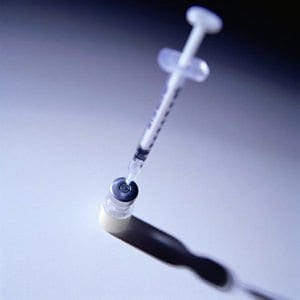 A registry analysis reports that patients who had been diagnosed with Type 2 diabetes and used insulin therapy to manage the disease were 19% more likely to die after a percutaneous coronary intervention than were diabetics who managed the disease through oral antiglycemic medication or with diet.
A registry analysis reports that patients who had been diagnosed with Type 2 diabetes and used insulin therapy to manage the disease were 19% more likely to die after a percutaneous coronary intervention than were diabetics who managed the disease through oral antiglycemic medication or with diet.
Even after researchers adjusted the results to account for the severity of the diabetes, the results remained the same. The findings were reported by Dr. Anna Norhammar with the Karolinska Institute of Sweden at the yearly meeting of the European Association for the Study of Diabetes.
“Patients with type 2 diabetes who are taking insulin are at a very high risk after cardiac angiography, especially if they have a history of previous myocardial infarction or renal complications,” said Dr. Norhammar. “We need to give these patients special attention and intensive handling.”
Dr. Norhammar’s research team used data on patients from two Swedish registries: the Swedish Coronary Angiography and Angioplasty Register (SCARR), which indexes all patients who have undergone those procedures, and the National Diabetes Registry, which holds data on about 70% of the Swedes diagnosed with diabetes. The research team identified 14,079 patients who had been indexed in both registries from 2001 through 2009; these patients were used to find the results of the study.
Patients were separated into four groups according to the type of treatment they received: those treated with diet alone, those treated with oral medications alone, those treated with insulin and oral medications, and those treated only with insulin.
The mean age of the patients was 69 years. The patients taking insulin only had the disease for an average of 15 years, while the patients who were being treated with therapies other than insulin had the disease for an average of 6 years.
Mean hemoglobin A1c in the patients rose along with the intensity of the treatment, from 6.5% in the group treated with diet to 7% in the group treated with oral medication to 7.8% in the groups treated with only insulin or with oral medication and insulin. The diet-only group had a 13% chance of developing retinopathy, compared to a 54% chance in the insulin-only group.
The insulin-only group also saw increased rates of heart failure (24%) compared to the other groups; the diet-only group was at 14% while the oral medication-only group was at 12% and the combination therapy group was at 17%. A significant number of the insulin-only group (39% of the patients) had suffered heart attacks while 29% of the diet-only group had such heart failure.
About 70% of the patients had been diagnosed with hypertension. The group treated with only insulin had a greater chance of developing renal insufficiency and peripheral artery disease, but the numbers were not statistically significant.
The patients’ angiographic results also varied according to the type of treatment they received. Of the patients treated with diet only, 22% had normal angiographic results; 17% of the insulin-only group had normal results. The insulin-only group had a higher rate of three-vessel disease, with 30% of the group developing the disease while only 23% of the diet-only group did the same.
After six months of treatment, the mortality rate was higher for the insulin-only group at 9%. Less intensive therapies indicated lower mortality rates, with the diet-only and oral medication group experiencing a 5% mortality rate and 7% for the combination therapy group.
By the four year mark, mortality in the insulin-only group was at 22% while the diet only group was at 15%; at the eight year mark, the insulin-only group’s mortality rate was over 50% while only 38% of the diet-only group had died.
Dr. Norhammar says it is unclear whether insulin-only treatment is directly responsible for the greater risks of disease and mortality or if it is simply a sign that the patient has a more advanced disease, which is likely to cause more complications and mortality.